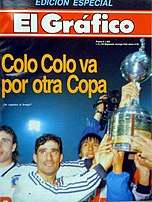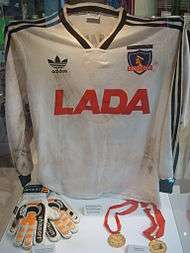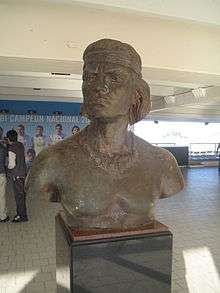Colo-Colo
Club Social y Deportivo Colo-Colo (Spanish pronunciation: [ˌkolo ˈkolo]) is a Chilean football club based in Macul, Santiago. Founded in 1925 by David Arellano and Guido Torres Henríquez,[1] they play in the Chilean Primera División, from which they have never been relegated.[2] The team has played its home games at Estadio Monumental David Arellano since 1989.[3] Colo-Colo is regarded as the most successful club of Chilean football.
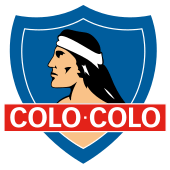 | |||
| Full name | Club Social y Deportivo Colo-Colo | ||
|---|---|---|---|
| Nickname(s) | Los Albos Eterno Campeón El Cacique | ||
| Founded | 19 April 1925 | ||
| Ground | Estadio Monumental David Arellano | ||
| Capacity | 47,347 | ||
| President | Aníbal Mosa | ||
| Manager | Marcelo Espina | ||
| Coach | Gualberto Jara | ||
| League | Chilean Primera División | ||
| 2019 | 2nd | ||
| Website | Club website | ||
|
| |||
Colo-Colo has won more Primera División de Chile (32) than any other Chilean club and a record eleven Copa Chile titles. It was the first Chilean team to win a continental tournament conquering the 1991 Copa Libertadores[4] Next year, the club went on to win two international titles that were 1992 Recopa Sudamericana[5] and 1992 Copa Interamericana,[6]
The club's most successful player is Luis Mena with eleven titles,[7] the historic top scorer is Esteban Paredes with 216 goals,[8] and the player with most appearances is the former goalkeeper Misael Escuti with 417 games.
Colo-Colo is the team with most supporters in Chile,[9] and holds a long-standing rivalry with Universidad de Chile. The club also holds a traditional rivalry in matches against Cobreloa and Universidad Católica. The IFFHS ranked the team in 14th place in 2007.[10] In 2009, that same institution named the team as the 20th century's top club of its country, and also within the top twenty clubs in South American football history.[11]
History
1925–1933: Foundation and early years
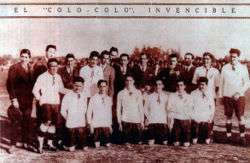
The team was founded in early 1925 by Magallanes' footballer David Arellano, who led a group of young players leaving that club after institutional problems.[12][13] Finally, on 19 April, Arellano and the other youths officially established the institutions after meetings and negotiations, where Luis Contreras chose the name Colo-Colo for the club,[14] which refers to the eponymous Mapuche cacique Colo Colo.
The team began to play friendly games, but in 1926, Colo-Colo took part in the Metropolitan League of Honour, where they were proclaimed champions (unbeaten) and earned the nickname of "invincible".[15] The following year, Colo-Colo became the first Chilean football team to participate in a tour across Europe. However, on 2 May, during an exhibition match against Real Unión Deportiva at Valladolid, the team founder and captain David Arellano was critically injured after suffering a collision with an opposing player, which caused him peritonitis.[16] The inflammation led him to his death the next day.[17] Despite the great impact caused by Arellano's death, the club won the Central League of football tournament – then renamed Asociación de Football de Santiago – in the 1928,[18] 1929[19] and 1930[20] seasons.
In the 1931–32 season, Colo-Colo suffered its first institutional crisis due to financial problems, which led to a salary reduction for first team footballers and board members, with their consequent resistance.[21] That season the team played another tournament final against Audax Italiano. However, due to a platform collapse at Estadio Italiano and the subsequent fracas between the fans, it was decided that the game would be suspended. In that moment, Colo-Colo were winning 2–1. That day's tragedy resulted in 130 injuries and three deaths.[22] The match was cancelled and the champion position for that year remained vacant.[22] Other authors however declared that both Audax Italiano and Colo-Colo were declared champions.[23][24]
1933–1973: Beginnings in professional football
In 1933, Colo-Colo alongside six clubs from Santiago decided to create the Chilean professional football league.[25] On 23 July, the team won the Campeonato de Apertura (Copa Chile precursor), after defeating 2–1 to Unión Española.[25] However, in the first Primera División official tournament, Colo-Colo finished first alongside Magallanes, which forced the "Cacique" to play a tie-breaker match. That match was lost 2–1 by Colo-Colo.[26] In 1937 the team was undefeated,[27] and reached its first league title.[28] Two seasons later, in 1939, Colo-Colo won the league title for a second time, now under the guidance of the Hungarian coach Francisco Platko,[29] and with Alfonso Domínguez as goalscorer with 20 goals in 24 matches.[30] After another title in 1941 with Platko as coach,[31] the club went on to win the titles of 1944[32] and 1947.[33] The following year Colo-Colo organized the South American Club Championship – Copa Libertadores background – in Santiago,[34] which brought together the 1947 continent's champions. In 1945, the club had the worst season in its history, finishing penultimate in eleventh place only ahead of weak Badminton.[35]
In the early 1950s, club's president Antonio Labán hired Newcastle United striker George Robledo, paying £25,000 for its signing.[36] Robledo's performances led the team to the titles of 1953[37] and 1956.[38] During that age, the club acquired a terrain at Macul, where began the construction of Estadio Monumental.[39] Besides the acquisition, the directive invested in a headquarters located at Santiago Centro (located at Cienfuegos 41) in 1953. The next decade Colo-Colo win the titles of 1960[40] and 1963.[41] The 1963 team broke two top-tier records: Luis Hernán Álvarez scored 37 goals in a single season[42] (the highest number of goals scored by a Colo-Colo footballer during a season)[42] and the netting of the highest number of goals scored by a club in a season (130).[43] The team won its tenth honour in 1970.[44]
Colo-Colo 1973 and 1980s dominance
In 1972, now under the orders of coach Luis Álamos [45] and with figures like Carlos Caszely and Francisco Valdés,[46] the club won another championship.[47] It also obtained the country's attendance record of 45,929 people for a single season.[48] That team was the basis of the so-called "Colo-Colo 73", the first Chilean team to reach a Copa Libertadores final, where it lost against Independiente of Argentina.[49] After Colo-Colo's brilliant campaign, the club went into a competitiveness and institutional crisis not being able to win another league title until 1979.[50] That team featured the talented Brazilian midfielder Severino Vasconcelos alongside a returning Caszely.[51] Nevertheless, in 1975, the construction of Estadio Monumental was finished and the stadium was inaugurated in a league match against Deportes Aviación, but due to problems with the infrastructure and other basic services the stadium was indefinitely closed.
In the 1980s, the club obtained the league titles of 1981 and 1983[52] with coach Pedro García, and the 1986[53] and 1989[54] honours under Arturo Salah. The 1987 Alianza Lima air disaster claimed the lives of sixteen players and Colo-Colo was the first to help the Peruvian team, loaning them 4 players.[55] Nonetheless the team won four Copa Chile titles in that decade. During that period, the greatest disappointment was at the continental tournament level with the team only exceeding the first stage in the 1988 Copa Libertadores. On September 30, 1989, the Estadio Monumental was re-inaugurated in an exhibition match against Peñarol, which Colo-Colo won 2–1[3] with goals by Marcelo Barticciotto and Leonel Herrera, the son of a 1970s legendary former defender of the same name.
1991–1999: International success
The 1990s was the most successful decade in the club's history for the national and international honours achieved. Croatian Mirko Jozić arrived as coach, leading the team towards its first Bicampeonato for winning two national titles in a row.[56] On June 5, 1991, after beating Olimpia 3–0 at Monumental with two goals by Luis Pérez and one by Leonel Herrera, Colo-Colo became the first Chilean team to win a Copa Libertadores. That same season, the "Albos" lost the Intercontinental Cup final against Yugoslavian club Red Star Belgrade, after being defeated 3–0 in Tokyo.[57] At the local level, the club won the 1991 league, its third-consecutive title thus achieving its first Tricampeonato.[58] The following season, the club won the Recopa Sudamericana, after beating Brazil's Cruzeiro in a penalty shootout, and also obtained the Copa Interamericana, after winning 3–1 against Puebla in Mexico. The last title won by Jozić in Colo-Colo was the 1993 league title, thus closing a successful spell in South America.[59]
After Jozić's departure came a brief drought in national titles, but the team managed to get an unforgettable 3-0 win over arch rivals Universidad de Chile in 1995. The team was champion of the 1994 Copa Chile and reached the 1994 Copa Libertadores quarterfinals. The following season saw the arrival of Paraguayan coach Gustavo Benítez, who obtained the 1996,[60] 1997-C[61] and 1998[62] league titles. The team advanced to the semifinals of the Supercopa Libertadores in 1996, and of the Copa Libertadores in 1997, being eliminated both times by Cruzeiro. In 1999, Colo-Colo relived something like 1994, finishing fourth in the Chilean league and having three coaches during that single season: Brazilian Nelsinho Baptista, the caretaker manager Carlos Durán and then Fernando Morena of Uruguay, who remained until 2001.
1999–present: Bankruptcy and recovery
In 1999, after Benítez's departure, the club entered a serious financial crisis. In 23 January 2002, after years of economic mismanagement under the leadership of Peter Dragicevic as president,[63] the club was declared bankrupt. Justice named Juan Carlos Saffie as syndic responsible for the institution allowing it not to lose its legal status.[63] Despite the bankruptcy, under Jaime Pizarro as coach – key player in the obtaining of the 1991 Copa Libertadores – Los Albos won the Torneo de Clausura, with an almost completely juvenile squad.[64] Three years later, in 2005, the joint-stock company Blanco y Negro[65] took over the administration, concessioning all club assets for thirty years in exchange for paying all debts through an opening process at the Santiago Stock Exchange.[63] In the first half of 2006, the judiciary court declared the bankruptcy over.[63]
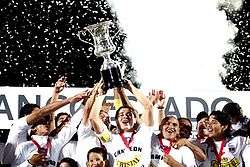
With the Argentine Claudio Borghi as coach since 2006, and with players like Matías Fernández and Humberto Suazo, Colo-Colo obtained a Bicampeonato winning the Apertura[66] and Clausura tournaments.[67] The squad reached another international final, the Copa Sudamericana, losing 2–1 to Mexico's side Pachuca. That season, El Cacique was recognized by the IFFHS as the world's club of the month.[68] The following season Colo-Colo won two more consecutive tournaments, winning a Tetracampeonato for winning four back-to-back championships, being the first Chilean team to achieve that.[69]
After Borghi's departure, the club obtained its 28th title after defeating Palestino in the 2008 Torneo de Clausura finals under the coaching of Marcelo Barticciotto, and with Lucas Barrios as principal scorer, who equaled Luis Hernán Álvarez's record of highest number of goals scored by a Colo-Colo footballer during a single season with 37 goals.[70] The following season, the club became the first professional team to play on Easter Island.[71] After a poor Torneo de Apertura 2009 – not reaching the play-offs for the first time – Los Albos started the Clausura very close to relegation positions. However, the team reached the tournament's finals against Universidad Católica, beating them 4–2 in Santa Laura, with players like Esteban Paredes, Macnelly Torres and Ezequiel Miralles, coached by Hugo Tocalli.[72] Colo-Colo's last championship was in 2014 after winning the Torneo de Clausura. It was the team's 30th Chilean League title.
Badge, colours and kit
The club's badge represents Mapuche chieftain Colo Colo, an important Wall Mapu member who fought in the Arauco War against the Spanish empire (1536–1818).[73] On 19 April 1925, when the club was established, Luis Contreras – one of the players that founded the club – defined the team's badge, in representation of the chief and the country's indigenous people.
Throughout its history, Colo-Colo's uniform has been a white shirt and black shorts. The uniform was originally designed by Juan Quiñones following the recommendations of David Arellano.
In 1927, after Arellano's died while playing against Real Unión Deportiva (currently Real Valladolid), it was decided then that the badge will wear a black horizontal band over it forever, to represent the institution's eternal mourning.
The team's away kits have varied through its history, from green between 1927 and the mid-1970s and to red from 1975 to 1988.
Stadium
Pedreros | |
 | |
| Location | Marathon Avenue #5300, Macul, Santiago, Chile |
|---|---|
| Owner | Colo-Colo |
| Operator | Colo-Colo |
| Capacity | 47,347 seated[74] |
| Construction | |
| Broke ground | 1975 |
| Opened | 30 September 1989 |
| Construction cost | US$1.5 million (1989) |
| Architect | Mario Recordón (1975) |
| Tenants | |
| Colo-Colo (1989–present) | |
Colo-Colo initially played on a field called Estadio El Llano but in January 1928 moved to the Campos de Sports de Ñuñoa. The team later moved to Estadio Nacional where it played from 1939 to the late 1980s. In 1946 the club bought a stadium from Carabineros de Chile – then called Fortín Mapocho – which was closed according security reasons. It was intended to build a 30,000 seat stadium at the site. However, a municipal ordinance prohibited construction in the area. For that reason, Colo-Colo sold the stadium in order to raise funds for the future Estadio Monumental.
In 1956, club's president Antonio Labán acquired a 28 ha terrain at Macul, close to the intersection between Vicuña Mackenna and Departamental. The new stadium was originally planned with a capacity of 120,000. Due to the work's high cost and lack of a government subsidy the project was halted. In 1960, after Chile's successful proposition to hold the World Cup, several congressmen proposed to build a 52,000-seat stadium at Colo-Colo's site. However, the 9.5 Valdivia earthquake and a willingness from congress stopped the initiative.
Colo-Colo's brilliant campaigns in 1972 and 1973 allowed the stadium construction to resume. It was inaugurated in a league match 1975 which Colo-Colo win 1–0 over Deportes Aviación with Juan Carlos Orellana, who become the first player to score a goal in Monumental's history.[75] However, the stadium was closed due to lack of basic services and infrastructure. It was not reopened until 1989 thanks to Hugo Rubio's transfer to Bologna which allowed the club to receive US$1 million to repair the problems mentioned. The stadium was called Monumental David Arellano in honour of its founder and its definitive inauguration was in a match against Uruguay's Peñarol which Colo-Colo won 2–1.[3]
Since its definitive opening, the stadium has seen the 1991 Copa Libertadores and 1992 Copa Interamericana titles as well as several league honors.
Monumental's public record attendance was in 1992 for a derby match with Universidad de Chile which registered an attendance of 70,000 fans approximately.[76] That record was closely followed in August 1993 during a 2–0 exhibition match win over Real Madrid with a 67,543 attendance.[77] Several remodeling works and stricter security brought down the total capacity to 47,347.
The Chilean national team usually use the stadium for its games since 1997.[78] The stadium was also used during the 2015 Copa América.
Players
Current squad of Colo-Colo as of 9 February 2019
()
Sources: Official Web Site
|
|
Coach: Gualberto Jara
2020 Summer transfers
In
Note: Flags indicate national team as defined under FIFA eligibility rules. Players may hold more than one non-FIFA nationality.
|
|
Out
Note: Flags indicate national team as defined under FIFA eligibility rules. Players may hold more than one non-FIFA nationality.
|
|
Managers
Current coaching staff
| Position | Name |
|---|---|
| Manager | |
| Assistant Manager | |
| Fitness Coach | |
| Goalkeeping Coach | - |
| Psychologist | - |
Supporters and rivalries
Colo-Colo is the club with the largest following in Chile, with approximately 42% of the total Chilean football fans according to research published in August 2012 by Spanish newspaper agency Marca.[79] The study showed a 4% growth in comparison to 2006 research by Fundación Futuro that ranked the club in first place with the 38% of the preferences, leaving its rival Universidad de Chile in second place.[80]
Since the early 1960s, the club has had organized fan groups, which evolved in the mid-1980s into the so-called Garra Blanca. They attended Colo-Colo's games and generally rioted, especially in derbies, turning Estadio Monumental surroundings into battlefields against the military police. In 2000, the group was declared as Barra brava.
Honours
Leagues
- Liga Central de Football / Asociación de Fútbol de Santiago: 4
- 1925, 1928, 1929, 1930
- Primera División: 32
Cups
Continental
- Copa Libertadores
- Copa Sudamericana
- Runner-up (1): 2006
- Copa Interamericana
- Winners (1): 1992
- Recopa Sudamericana
- Winners (1): 1992
International
- Intercontinental Cup
- Runner-up (1): 1991
See also
Notes
Citations
- "La Fundación del Club (1920-1930)". colocolo.cl (in Spanish). Colo Colo. 13 December 2015. Retrieved 19 December 2018.
- "La selecta lista de los equipos sudamericanos que nunca han descendido". Elgrafico.cl (in Spanish). El Gráfico. 29 August 2012. Retrieved 22 September 2014.
- "¡Feliz Cumpleaños, Estadio Monumental!". Sitio Oficial de Colo-Colo (in Spanish). 2009. Retrieved 17 June 2011.
- "Colo Colo recuerda la gloriosa jornada en que conquistó la Copa Libertadores". Emol.com (in Spanish). Emol. 5 June 2011. Retrieved 22 September 2014.
- "Hace 20 años, Colo Colo trajo la Recopa Sudamericana a Chile". Charlatecnica.cl (in Spanish). Charla Técnica. 21 August 2012. Archived from the original on 23 August 2012. Retrieved 22 September 2014.
- "Colo Colo Campeón Copa Interamericana". Dalealbo.cl (in Spanish). Dale Albo. 23 September 2011. Archived from the original on 13 July 2015. Retrieved 22 September 2014.
- "Jugadores con mas Ganadores (Títulos)". Dalealbo.cl. Retrieved 23 March 2013.
- "Muere Francisco Valdés, goleador histórico del fútbol chileno". La Tercera. 18 August 2009. Archived from the original on 16 October 2009.
- "Colo-Colo es el equipo más popular". La Nación. Retrieved 6 February 2013.
- "IFFHS' 2007 Ranking". IFFHS.com. Archived from the original on 26 January 2009. Retrieved 11 August 2017.
- "South America's Club of the Century". IFFHS. Archived from the original on 1 October 2009. Retrieved 11 August 2017.
- Salinas, Sebastián (2005), p. 37.
- Salinas, Sebastián (2005), p. 52.
- Salinas, Sebastián (2005), p. 44.
- Salinas, Sebastián (2005), p. 53.
- Salinas, Sebastián (2005), p. 70.
- "Los domingos footballísticos" (PDF). Zig-Zag. Los Sports. 1925–1927. Retrieved 17 March 2013.
- Salinas, Sebastián (2005), p. 184.
- Salinas, Sebastián (2005), p. 215.
- Salinas, Sebastián (2005), p. 245.
- Salinas, Sebastián (2005), p. 309.
- Salinas, Sebastián (2005), pp. 299–300.
- Larraín, Fernando (1940), p. 38.
- La Nación (1985), pp. 12 and 32.
- Salinas, Sebastián (2005), p. 327.
- Espina, Eduardo (2005). "Chile 1933". Rec.Sport.Soccer Statistics Foundation (RSSSF). Retrieved 2007. Check date values in:
|accessdate=(help) - Marín, Edgardo (1988), p. 33.
- Espina, Eduardo (2005). "Chile 1937". Rec.Sport.Soccer Statistics Foundation (RSSSF). Retrieved 2007. Check date values in:
|accessdate=(help) - Marín, Edgardo (1988), p. 43.
- Marín, Edgardo (1988), p. 42.
- Espina, Eduardo (2005). "Chile 1941". Rec.Sport.Soccer Statistics Foundation (RSSSF). Retrieved 2007. Check date values in:
|accessdate=(help) - Espina, Eduardo (2005). "Chile 1944". Rec.Sport.Soccer Statistics Foundation (RSSSF). Retrieved 2007. Check date values in:
|accessdate=(help) - Espina, Eduardo (2005). "Chile 1947". Rec.Sport.Soccer Statistics Foundation (RSSSF). Retrieved 2007. Check date values in:
|accessdate=(help) - Bekerman, Esteban (2008). "Hace 60 años, River perdía la gran chance de ser el primer club campeón de América". Perfil.com. Retrieved 10 May 2008.
- Espina, Eduardo (2005). "Chile 1945". Rec.Sport.Soccer Statistics Foundation (RSSSF). Retrieved 2007. Check date values in:
|accessdate=(help) - Marín, Edgardo y Salviat, Julio (1975), p. 105.
- Espina, Eduardo (2005). "Chile 1953". Rec.Sport.Soccer Statistics Foundation (RSSSF). Retrieved 2007. Check date values in:
|accessdate=(help) - Espina, Eduardo (2005). "Chile 1956". Rec.Sport.Soccer Statistics Foundation (RSSSF). Retrieved 2007. Check date values in:
|accessdate=(help) - Marín, Edgardo y Salviat, Julio (1975), p. 119.
- Espina, Eduardo (2005). "Chile 1960". Rec.Sport.Soccer Statistics Foundation (RSSSF). Retrieved 2007. Check date values in:
|accessdate=(help) - Espina, Eduardo (2005). "Chile 1963". Rec.Sport.Soccer Statistics Foundation (RSSSF). Retrieved 2007. Check date values in:
|accessdate=(help) - Marín, Edgardo y Salviat, Julio (1975), p. 130.
- Marín, Edgardo y Salviat, Julio (1975), p. 131.
- Marín, Edgardo y Salviat, Julio (1975), p. 160.
- Marín, Edgardo y Salviat, Julio (1975), p. 188.
- Marín, Edgardo (1988), p. 250.
- Espina, Eduardo (2005). "Chile 1972". Rec.Sport.Soccer Statistics Foundation (RSSSF). Retrieved 2007. Check date values in:
|accessdate=(help) - "Especial Colo Colo 1972". Minuto 90. 2005. Retrieved 2013. Check date values in:
|accessdate=(help) - Marín, Edgardo y Salviat, Julio (1975), p. 193.
- Espina, Eduardo (2005). "Chile 1979". Rec.Sport.Soccer Statistics Foundation (RSSSF). Retrieved 2007. Check date values in:
|accessdate=(help) - Marín, Edgardo (1988), p. 298.
- Espina, Eduardo (2005). "Chile 1981". Rec.Sport.Soccer Statistics Foundation (RSSSF). Retrieved 2007. Check date values in:
|accessdate=(help) - Espina, Eduardo (2005). "Chile 1986". Rec.Sport.Soccer Statistics Foundation (RSSSF). Retrieved 2007. Check date values in:
|accessdate=(help) - Espina, Eduardo (2005). "Chile 1989". Rec.Sport.Soccer Statistics Foundation (RSSSF). Retrieved 2007. Check date values in:
|accessdate=(help) - "En Perú conmemoran 25 años de la tragedia área que enlutó a Alianza Lima". La Tercera. 8 December 2012.
- Espina, Eduardo (2005). "Chile 1990". Rec.Sport.Soccer Statistics Foundation (RSSSF). Retrieved 2007. Check date values in:
|accessdate=(help) - "Copa Intercontinental 1991: Estrella Roja 3–0 Colo Colo". Dalealbo.cl. 23 October 2008. Retrieved 23 March 2013.
- Espina, Eduardo (2005). "Chile 1991". Rec.Sport.Soccer Statistics Foundation (RSSSF). Retrieved 2007. Check date values in:
|accessdate=(help) - Espina, Eduardo (2005). "Chile 1993". Rec.Sport.Soccer Statistics Foundation (RSSSF). Retrieved 2007. Check date values in:
|accessdate=(help) - Espina, Eduardo (2005). "Chile 1996". Rec.Sport.Soccer Statistics Foundation (RSSSF). Retrieved 2007. Check date values in:
|accessdate=(help) - Espina, Eduardo (2005). "Chile 1997". Rec.Sport.Soccer Statistics Foundation (RSSSF). Retrieved 2007. Check date values in:
|accessdate=(help) - Espina, Eduardo (2005). "Chile 1998". Rec.Sport.Soccer Statistics Foundation (RSSSF). Retrieved 2007. Check date values in:
|accessdate=(help) - Vivanco del Río, Pedro Pablo. "Historia de Colo-Colo en Internet". Todoalbo.cl. Retrieved 23 March 2013.
- Espina, Eduardo (2005). "Chile 2002". Rec.Sport.Soccer Statistics Foundation (RSSSF). Retrieved 2007. Check date values in:
|accessdate=(help) - Sitio Oficial de Colo-Colo (2013). "Información Corporativa Club Social y Deportivo Colo Colo 2013". Retrieved 25 April 2013.
- "Bravo por el eterno campeón". Papel Digital. 21 February 2008. Archived from the original on 11 January 2009. Retrieved 24 March 2013.
- "Festejo entre copas". Papel Digital. 20 February 2008. Archived from the original on 12 January 2009. Retrieved 24 March 2013.
- "The world's club of the month". IFFHS. 20 October 2006.
- "Blanca Navidad". La Tercera. Archived from the original on 11 January 2009. Retrieved 20 February 2008.
- "¡Colo Colo campeón! Logró su estrella 28 con histórico goleador". La Tercera. 20 December 2008.
- "Juego del siglo en Rapa Nui". FIFA.com. 6 August 2009.
- "No hay caso con Colo-Colo de amenazado con el descenso a campeón". Emol.com. 9 December 2009.
- "Historia del mapuche Colocolo". El Maule. 19 April 2012. Retrieved 10 April 2013.
- "Estadio Monumental". Todoalbo.cl. 2011. Retrieved 1 April 2013.
- "Una historia monumental". Colocolo.cl. Retrieved 13 September 2015.
- "Historia de la Ley Nº 19.327. Fija normas para prevención y sanción de hechos de violencia en recintos deportivos con ocasión de espectáculos de futbol profesional" (PDF). Diario Oficial. Biblioteca del Congreso Nacional de Chile. 1994. Retrieved 7 July 2007.
- "2-0: Derrota del Real Madrid ante Colo-Colo". Diario ABC. EFE. 1993. Retrieved 7 July 2007.
- "Chile vs. Venezuela: A repetir la mágica noche Monumental". Prensa Fútbol. 5 September 2009. Archived from the original on 18 May 2013. Retrieved 19 April 2013.
- "Chile es del 'Colo' aunque gane la 'U'". Marca.com. 23 August 2012.
- "Mundial" (PDF). Fundación Futuro. 31 October 2007. Archived from the original (PDF) on 3 October 2013. Retrieved 30 March 2013.
Further reading
- Larraín, Fernando (1940). Club Deportivo Magallanes. Memorias Históricas. Santiago: Tall. de Molina Lackington y Cia.
- Jaime, Drapkin S. (1952). Historia de Colo-Colo Club de Deportes 1925–1952. Without editorial indication.
- Jaime, Marín, Edgardo y Salviat, Julio (1975). De David a "Chamaco": medio siglo de goles. Santiago: Editorial Nacional Gabriela Mistral.
- Historia del fútbol chileno. Tomo 2. La Nación. 1985.
- Salinas, Sebastián (2004). Por Empuje Y Coraje. Los Albos en la época amateur 1925–1933. Santiago: Central de Estadísticas Deportivas (Cedep). ISBN 956-299-125-3.
